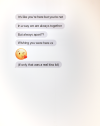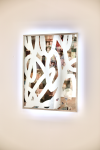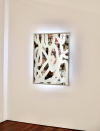Alexandra
Jonscher



What might a future archaeologist uncover if they were unearthing the traces of one’s digital grave? Resin sculptures alluding to minerals hold preserved text from the artist’s personal Apple Notes archive. There is a symbolic intimacy that exists in the Notes app. To the smart phone generation, your Notes are your diary entries, shopping lists, passwords, drunken shower thoughts, and un-sent texts drafted to exes. They are the intimate, somewhat chaotic, deeply personal archive of the self. More significantly, it’s an archive that exists outside of network circulation. These digital relics signify power in their privacy, suggesting that the most precious parts of ourselves are those which we choose not to share online.
Marking this grave is a neon blue headstone alluding to the signage of marketing. It’s etched with text sourced from the Spam inbox of the artist’s first email address, alliej52a@hotmail.com. By taking information from unsolicited advertising and turning it into an epitaph, it presents the language of surveillance capitalism as an absurd dark comedy. Situated in concrete rubble, the future ruin of our urban world, the work considers the legacy of ourselves we leave behind in the ever-growing archive of our digital lives.



This passage of text is written by the artist as if she is writing to the audience as her virtual lover. Communicating through art shares similarities with how we communicate through technology; always through a mediated form but inviting infinite potentials for connection and interpretation. There is a specific kind of intimacy that exists in both digital messaging and art exhibitions. You are vulnerable but protected. You are connected but separated. You are communicating without talking. As artists this dialogue informs how we make choices about what we choose to make and not make. These text messages reflect on the paradoxical sense of disconnection and connection that underpins our relationship with virtual interactions and artistic practice. By framing these texts as a device in the gallery alluding to a curatorial introduction, the work considers how we communicate in the digital age and the yearning for art to bring us closer together.

SENIOR CITIZEN started with an image the artist posted to Facebook years ago of her now dead grandparents. The work functions as an uncanny, artificial resurrection. Across the internet, there are traces of deceased users whose data give their identity an allusion of immortality. The image’s URL was entered into Google Image Search in a bid to “search” for these lost relatives online. The work references the common practice of stalking people online to try and construct meaning about their identity, and toys with the assumption that Google will provide meaningful answers. In processing the image, Google named it “SENIOR CITIZENS”. The results of the search have been collated into a painterly composition of overlayed opaque images, printed on clear vinyl, and mounted on a backlit mirrored surface. The materiality aims to mimic the experience of looking at, and around a screen as destabilising for the viewer and the allusion of warmth and intimacy simulated by contemporary design practices. The composition is partially erased, tracing between real and artificial space, reflecting how algorithms may bring you close to what you’re looking for, but they will never show you the truth, as online space can obscure, abstract and distract from reality.
SENIOR CITIZEN started with an image the artist posted to Facebook years ago of her now dead grandparents. The work functions as an uncanny, artificial resurrection. Across the Internet, there are traces of deceased users whose data give their identity an allusion of immortality. The image’s URL was entered into Google Image Search in a bid to “search” for these lost relatives online. The work references the common practice of stalking people online to try and construct meaning about their identity, and toys with the assumption that Google will provide meaningful answers. In processing the image, Google named it “SENIOR CITIZEN”. The results of the search have been collated into a painterly composition of overlayed opaque images, printed on clear vinyl, and mounted on a backlit mirrored surface. The materiality aims to mimic the experience of looking at, and around a screen. The composition is partially erased, tracing between real and artificial space. The work reflects on how algorithms may bring you close to what you’re looking for, but they will never show you the truth.
View Process Here.


Bio
Alexandra Jonscher is a multidisciplinary artist and curator exploring the dynamics of digital technology and the Internet. Working across painting, sculpture, text, and installation, she uses virtual encounters and online networks to inform the production of her work. Key questions she investigates relate to how we navigate a networked reality as mutable bodies and questions the authorities that dictate algorithmic systemisation. In 2020 she was featured in Hatched: The National Graduate Show at Perth Institute of Contemporary Art.